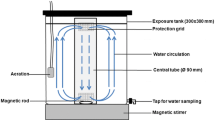Abstract
In order to simulate an offshore oil spill event, we assessed the acute toxicity of the non-dispersed and the chemically dispersed water-accommodated fraction (WAF) of crude oil using Louisiana sweet crude and Corexit® 9500A with juvenile Harris mud crabs (Rhithropanopeus harrisii), an important Gulf of Mexico benthic crustacean. The chemical dispersion of crude oil significantly increased acute toxicity of the WAF in juvenile mud crabs compared to naturally dispersed oil. The majority of the mortality in the chemically dispersed treatments occurred within 24 h. While higher concentrations of chemically dispersed WAF had no survivors, at lower concentrations surviving juvenile crabs displayed no long-term effects. These results suggest that if the juvenile crabs survive initial exposure, acute exposure to dispersed or non-dispersed crude oil may not induce long-term effects.


Similar content being viewed by others
References
Benner Jr. RA, El Said KR, Jester ELE, Flurer RA, Boyd BL, Gamble B, Gratz S, Mulligan KJ, Heitkemper DT, Burrows DG, da Silva DAM, Krahn MM, Reichert WL, Ylitalo GM, Plakas SM, Seyfert-Margolis V, Dickey R (2010) Investigation of Corexit 9500 dispersant in Gulf of Mexico seafood species USFDA, pp 1–22
Crone TJ, Tolstoy M (2010) Magnitude of the 2010 Gulf of Mexico oil leak. Science 6004:634
Forward RB (2009) Larval biology of the crab Rhithropanopeus harrisii (Gould): a synthesis. Biol Bull 3:243–256
George-Ares A, Clark JR (2000) Aquatic toxicity of two Corexit® dispersants. Chemosphere 8:897–906
Hemmer MJ, Barron MG, Greene RM (2010) Comparative toxicity of Louisiana sweet crude oil (LSC) and chemically dispersed LSC to two Gulf of Mexico aquatic test species. U.S. Environmental Protection Agency Office of Research and Development, pp 1–13
Khan RA, Payne JF (2005) Influence of a crude oil dispersant, Corexit 9527, and dispersed oil on capelin (Mallotus villosus), Atlantic cod (Gadus morhua), longhorn sculpin (Myoxocephalus octodecemspinosus), and cunner (Tautogolabrus adspersus). Bull Environ Contam Toxicol 1:50–56
Klerks PL, Nyman JA, Bhattacharyya S (2004) Relationship between hydrocarbon measurements and toxicity to a chironomid, fish larva and daphnid for oils and oil spill chemical treatments in laboratory freshwater marsh microcosms. Environ Pollut 3:345–353
Kujawinski EB, Kido Soule MC, Valentine DL, Boysen AK, Longnecker K, Redmond MC (2011) Fate of dispersants associated with the Deepwater Horizon oil spill. Environ Sci Technol 4:1298–1306
McIntosh S, King T, Wu DM, Hodson PV (2010) Toxicity of dispersed weathered crude oil to early life stages of Atlantic herring (Clupea harengus). Environ Toxicol Chem 5:1160–1167
NOAA (2010) Deepwater Horizon oil: characteristics and concerns. National oceanic and atmospheric administration. Office of Response and Restoration, pp 1–2
Overton EB, Ashton BM, Miles MS (2004) Historical polycyclic aromatic and petrogenic hydrocarbon loading in Northern Central Gulf of Mexico shelf sediments. Mar Pollut Bull 7–8:557–563
Roth AM, Baltz D (2009) Short-term effects of an oil spill on marsh-edge fishes and decapod crustaceans. Estuar Coast 3:565–572
Schein A, Scott JA, Mos L, Hodson PV (2009) Oil dispersion increases the apparent bioavailability and toxicity of diesel to rainbow trout (Oncorhynchus mykiss). Environ Toxicol Chem 3:595–602
Singer M, George S, Jacobson S, Lee I, Weetman L, Tjeerdema R, Sowby M (1996) Comparison of acute aquatic effects of the oil dispersant Corexit 9500 with those of other Corexit series dispersants. Ecotoxicol Environ Saf 2:183–189
US Environmental Protection Agency (1992) User Guide PROBIT program, Version 1.5. Environment Monitoring Systems Laboratory, U.S. Environmental Protection Agency, Cincinnati
US Environmental Protection Agency (1996) Semivolatile organic compounds by gas chromatography/mass spectrometry (GC/MS) EPA method 8270C. Environmental Protection Agency. Pacific Southwest Region 9, p 54
Acknowledgments
The authors would like to thank Louisiana Sea Grant College Program for funding as well as two anonymous reviewers, Stanley Massett, Paul Bangs, Holly Rogers, Christopher Green, and Andrew Nyman for assistance with the project or manuscript.
Author information
Authors and Affiliations
Corresponding author
Electronic supplementary material
Below is the link to the electronic supplementary material.
128_2014_1216_MOESM1_ESM.pdf
Full list of 74 target PAHs concentrations in the 100% chemically enhanced water-accommodated fraction (CE) and 100% water-accommodated fraction (WAF). ND stands for no detection (PDF 16 kb)
Appendix
Appendix
Full list of 74 target PAHs used to calculate the expanded total PAH concentration.
Constituent | ||
|---|---|---|
cis/trans-Decaiin | C3-Phens/Anths | Benzo(b)fluoranthenea |
Cl-Decalins | C4-Phens/Anths | Benzo(k)fluoranthenea |
C2-Deca1ins | Relent | Benzo(a)fluoranthene |
C3-Decalins | DibenzothiopheneQDBI) | Benzo(e)pyrenea |
C4-Decalins | Cl-DBT | C30-Hopane |
Benzo(b)thiophenes | C2-DBF | Benzo(a)pyrenea |
Cl-Benzotbiophenes | C3-DBT | Perylenea |
C2-Benzotbiophenes | C4-DBT | Indeno(1,2,3-cd)pyrenea |
C3-Bcnzothiophcncs | Bcnzo(b)fluorene | Dibenz(a,h)anthracenea |
C4-Benzothiophenes | Fluoranthene (Tluors)a | Benzo(g,h,i)perylenea |
Naphthalenea | Pyrene (Pyrs)a | 4-Methyldibenzothiophene |
C1-Naphthalenes | C1-Fluors/Pyrs | 2-Methyldibenzothiophene |
C2-Naphthalenes | C2-Fluors/Pyrs | 1-Mcthyldibcnzothiophene |
C3-Naphthalenes | C3-Fluors/Pyrs | 3-Methylphenanthrene |
C4-Naphthalenes | C4-Fluors/Pyrs | 2-Methylphenanthrene |
Biphenyla | Naphrhobenzothiophene(NBT) | 2-Methylanthracene |
Acenapbthylenea | Cl-NBT | 9-Methylphenanthrene |
Acenaphthenea | C2-NB1 | 1-Methylphenanthrenea |
Fluorenea | C3-NBF | 2-Methylnaphthalenea |
G1-Flnorenes | C4-NBT | 1-Melthlnaphthalenea |
C2-Fluorenes | Benz(a)anthracenea | 2,6-Dimethylnaphthalenea |
C3-Fluorenes | Chrysenea | 2,3,5-Trimethylnaphthalenea |
Anthracene (Anths)a | Cl-Chrysenes | Carbazole |
Phenanthrene (Phens)a | C2-Chrysenes | |
Cl-Phens/Anths | C3-Cluysenes | |
C2-Phcns/Anths | C4-Chryscncs | |
Rights and permissions
About this article
Cite this article
Anderson, J.A., Kuhl, A.J. & Anderson, A.N. Toxicity of Oil and Dispersed Oil on Juvenile Mud Crabs, Rhithropanopeus harrisii . Bull Environ Contam Toxicol 92, 375–380 (2014). https://doi.org/10.1007/s00128-014-1216-7
Received:
Accepted:
Published:
Issue Date:
DOI: https://doi.org/10.1007/s00128-014-1216-7




